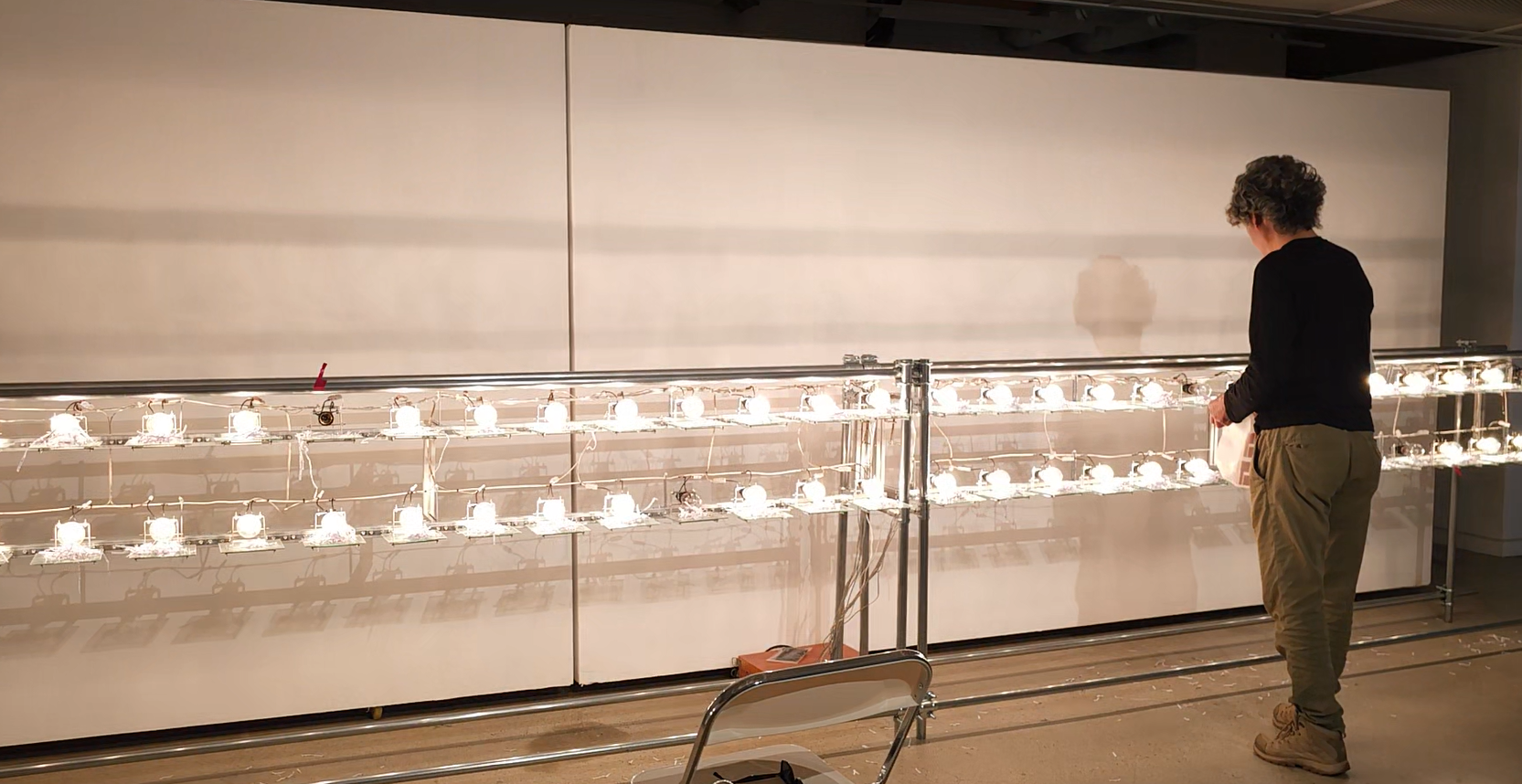

나는 너를 모른다 : I Don’t Know You
LEE Tal I Don’t Know You는 2025년에 제작된 대형 설치 작품으로, 크기는 6,000 × 1,200 × 500mm이며 조명장치, 아두이노, 센서, 릴레이, 금속 프레임으로 구성된다. 수십 개의 백열전구가 포탄의 섬광처럼 켜졌다 꺼지며, 바닥에 흩어진 종이 파편을 일시적으로 비춘다. 이 장치는 단순한 시각적 장면을 넘어, 권력에 의해 은폐되고 조작된 진실을 드러내는 은유적 장치다.
작품은 국제 재판소의 형식을 차용한 비공식 사건 번호와 알 수 없는 의미의 파쇄된 종이 조각들을 제시한다. 이 파편화된 기록은 법과 권력의 모순을 비판하며, 사법 절차 속에서 지워진 이름 없는 존재들의 이야기를 현재로 불러낸다.
빛과 어둠: 윤리적 신호로서의 조명
LEE Tal의 작품에서 빛은 단순히 공간을 밝히는 장치가 아니다. 백열전구의 강렬한 점멸은 포탄의 섬광처럼 폭력적이면서도, 동시에 어둠 속에 잠시 드러나는 진실의 흔적을 상징한다.
이 빛은 존재와 부재의 경계를 가로지르는 윤리적 신호다. 관객은 전구가 켜지는 순간 자신이 무언가를 보았다고 확신하지만, 곧 어둠 속에 남겨지며 ‘인지의 공백’을 경험하게 된다. 이는 우리가 진실을 인지한다고 믿는 순간조차 권력의 프레임 속에서 제한적임을 드러낸다.
파편화된 기록과 백비(白碑)
작품에 사용된 종이 파편은 의미를 알 수 없게 조각나 있으며, 사건 기록 같지만 동시에 공허하다. 이는 역사 속에서 사라진 이름 없는 존재들, 권력에 의해 삭제되거나 왜곡된 서사를 상징한다.
LEE Tal은 이를 백비(白碑)의 이미지와 연결한다. 백비는 공적(功績)을 새기지 않은 비석으로, 존재하지만 이름이 지워진 상태를 의미한다. 작품 속 종이 파편과 빛의 조합은 이러한 익명의 서사를 현재로 소환하며, 관객에게 보이지 않는 진실에 대해 질문을 던진다.
관객 경험: 인지와 공백의 교차
관객은 작품을 경험하는 순간, 단순한 시각적 감상을 넘어 인지적 불안정성을 체험한다. 빛은 순간적으로 기록을 드러내지만, 곧 사라지며 관객의 기억 속에만 잔상을 남긴다. 이는 권력 구조 속에서 진실이 어떻게 드러나고 은폐되는지를 직접 체험하게 한다.
관객은 작품 앞에서 “나는 무엇을 보았는가?”, 진실은 어디에 존재하는가?”라는 질문에 직면한다. 이때 경험되는 긴장감은 예술이 권력과 윤리에 대해 사유할 수 있는 장치임을 보여준다.
두 작품을 잇는 서사적 맥락
LEE Tal의 또 다른 작업들은 종종 기계적 장치와 빛을 활용하여 기억과 권력의 관계를 탐구한다. 그 중에서도 〈I Don’t Know You〉는 파편화된 기록과 조명이라는 요소를 통해, 사회적 망각과 정치적 은폐를 집약적으로 드러낸다.
이 작업은 단일한 사건을 재현하는 것이 아니라, 보이지 않는 서사를 호출하는 예술적 장치다. 빛과 어둠, 기록과 파편, 존재와 부재라는 대립 구조 속에서 관객은 자신의 위치를 재고하고, 이름 없는 존재들과의 윤리적 연대를 상상하게 된다.
LEE Tal I Don’t Know You의 의미
궁극적으로 LEE Tal I Don’t Know You는 빛과 어둠, 파편화된 기록과 백비의 이미지를 통해 권력과 진실의 모순을 드러낸다. 작품은 관객에게 단순한 시각적 체험을 넘어, 존재와 부재의 경계에서 발생하는 윤리적 질문을 던진다.
이 설치미술은 권력에 의해 은폐된 서사와 망각된 존재들을 다시 불러내며, 우리가 보는 것과 보지 못하는 것, 알고 있다고 믿는 것과 실제로 알 수 없는 것 사이의 간극을 드러낸다. 결국 LEE Tal I Don’t Know You는 현대 사회에서 예술이 수행할 수 있는 비판적 기능과 윤리적 사유의 장을 제시한다.
LEE Tal’s I Don’t Know You (2025) is a large-scale installation composed of lighting devices, Arduino, sensors, relays, and a metal frame. Dozens of incandescent bulbs flash on and off like artillery bursts, briefly illuminating scattered paper fragments on the floor. This apparatus functions not as a mere visual scene but as a metaphorical device that exposes truths concealed and manipulated by power.
The work borrows the format of an international tribunal, presenting unofficial case numbers and shredded paper fragments whose meaning remains obscure. These fragmented records critique the contradictions of law and power, summoning into the present the erased stories of nameless figures silenced within judicial processes.
Light and Darkness: Illumination as Ethical Signal
In LEE Tal’s work, light is never a neutral agent of illumination. The violent flicker of incandescent bulbs resembles the flash of an explosion—at once aggressive and fleeting—yet it also symbolizes the brief trace of truth revealed within darkness.
Here, light becomes an ethical signal crossing the boundary between presence and absence. When the bulbs ignite, the viewer feels certain they have seen something; yet as the space is plunged back into darkness, they are left within an “epistemic void.” This reveals how even our moments of supposed recognition remain constrained within the frameworks of power.
Fragmented Records and the White Stele
The shredded paper fragments within the work are stripped of meaning, resembling case records while also standing as hollow signs. They symbolize histories erased, distorted, or suppressed by structures of authority.
LEE Tal connects this imagery to the white stele (baekbi)—a monument left blank, uninscribed with merit or achievement. It exists, yet its names are erased. Through the interplay of fragmented paper and intermittent light, the work resurrects these anonymous narratives and confronts the audience with questions about truths that remain unseen.
Viewer Experience: The Intersection of Perception and Absence
The audience’s experience extends beyond visual perception to a state of cognitive instability. The flashing lights reveal records only to withdraw them moments later, leaving residual impressions solely in memory. This sensory tension forces viewers to directly experience how truths are alternately revealed and concealed within structures of power.
In this space, spectators confront pressing questions: “What did I see?” and “Where does truth reside?” The unease that arises in this encounter demonstrates how art can serve as a medium for reflection on power and ethics.
Narrative Context Within LEE Tal’s Practice
Many of LEE Tal’s other works also employ mechanical devices and light to probe the relationship between memory and authority. Among them, I Don’t Know You is particularly concentrated in its approach: by staging fragmented records and intermittent illumination, it encapsulates themes of social amnesia and political concealment.
The work does not re-enact a single event but instead calls forth unseen narratives. Through the dialectics of light and darkness, record and fragment, presence and absence, the viewer is invited to reconsider their own position and to imagine an ethical solidarity with erased and nameless existences.
The Significance of LEE Tal’s I Don’t Know You
Ultimately, LEE Tal’s I Don’t Know You reveals the contradictions of power and truth through the imagery of light and darkness, fragmented records, and the blank stele. It offers more than visual spectacle: it poses ethical questions that emerge at the boundary of presence and absence.
This installation reanimates stories suppressed by power and forgotten by society, exposing the gap between what we see and what remains unseen, what we believe we know and what cannot be known. In doing so, I Don’t Know You positions itself as a critical space of ethical reflection, demonstrating the enduring role of art in confronting the structures of concealment in contemporary society.


